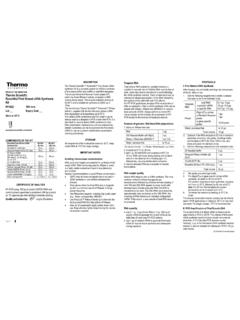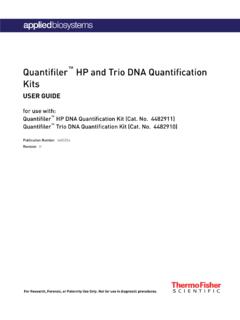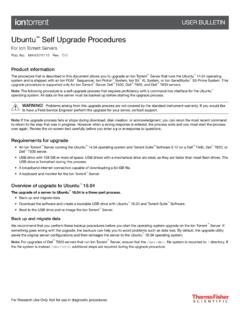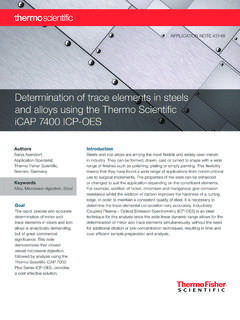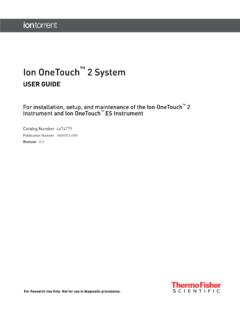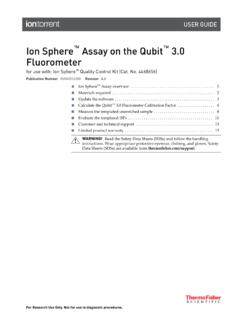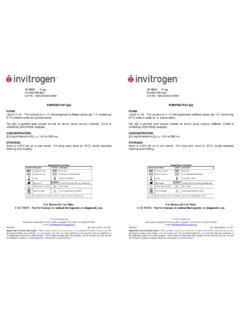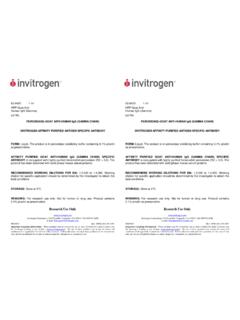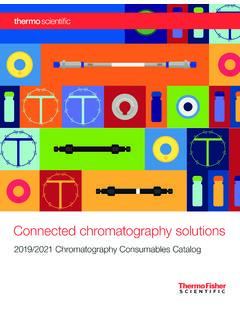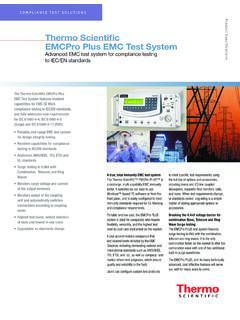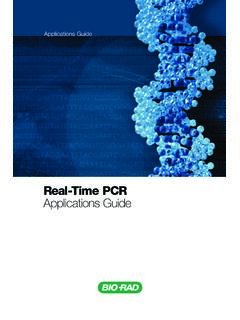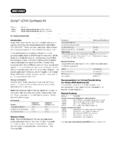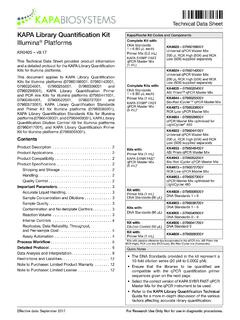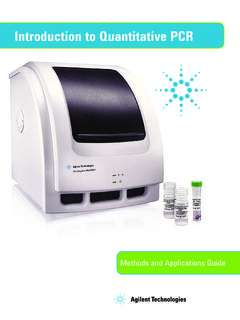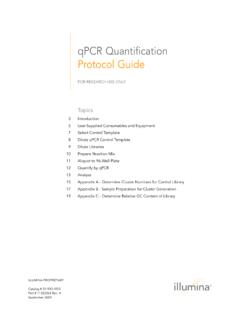Transcription of QPCR Optimization & Troubleshooting Guide
1 qpcr Optimization & Troubleshooting GuideDETECTEEEEEEEEEEEEEETTTTTTTTTTTTTTE EEEEEEEEEEEEEECCCCCCCCCCCCDDDDDDDDDDDDDT TTTTTTTTTTTTT02 IntroductionWhether you are beginning to develop a qpcr assay, have a qpcr assay you want to optimize, or are getting questionable results and don t know why, this Guide is for bringing together all the necessary components for qpcr is often not enough to obtain accurate and consistent results . Following a protocol that instructs you how to combine your template with reagents before running them on your chosen instrument only covers the basics of real-time PCR. The science of real-time PCR comes from understanding how the nuances of this technique affect your quick reference Guide is intended to educate you to gain a better understanding of these finer details, empowering you to optimize or troubleshoot your assay in order to achieve the best results possible on a consistent basis.
2 It captures the knowledge that we have accumulated over 20 years manufacturing and optimizing PCR reagents and plastics for the life science industry. DETECTEEEEEEEEEEEEEETTTTTTTTTTTTTTEEEEEE EEEEEEEEECCCCCCCCCCCCDDDDDDDDDDDDDTTTTTT TTTTTTTTOPTIMIZATION PARAMETERRECOMMENDATIONQPCR PlateIt is recommended that opaque white PCR plates are used for qpcr analysis. The white color virtually eliminates cross talk and improves the efficiency of fluorescent detection thereby increasing assay sensitivity and well-to-well consistency. Template QualityIt is essential that the nucleic acid is sufficiently pure for qpcr analysis. Template contamination (ie. genomic DNA, protein, carbohydrates or organic solvents) can have a huge impact on assay reliability and reproducibility. Template quality should be determined by spectrophotometry (ie.)
3 Nanodrop), microfluidics or SizeIdeally, the amplicon should always be between 100bp and 150bp to ensure the qpcr reaction efficiency is as close to 100% as possible. Good qpcr efficiency promotes assay reproducibility and sensitivity. Primer DesignGiven that PCR primers are a relatively cheap component of a qpcr assay, it is good practice to order and test at least 2 primer pairs for every new qpcr assay. This will maximize the chance of establishing a reliable, reproducible and sensitive assay. Test PrimersMeasure the reproducibility, specificity, sensitivity and dynamic range of your qpcr assay using SYBR Green chemistry across a template dilution series. Ideally, the efficiency of the qpcr reaction should be at least 90% and below 105%, while the assay reproducibility should be higher then r= RTInitially, the RT step should be performed as specified in the supplier protocol.
4 However, the length and the temperature of the RT step can be optimized to increase the efficiency of the reverse transcriptase. The reverse transcriptase should be tested across a range of RNA concentrations to ensure assay Thermo Scientific qpcr master mixes require a 15 minute heating step at 95oC to ensure the hot-start Taq is fully activated. This step cannot be shortened under any circumstances. A shorter heating step will impact assay reproducibility and ProtocolEven if your assay has been optimized using an alternative supplier s mix, once the Thermo-Start mix is used it is advisible to start using the protocol recommended in the Thermo Scientific qpcr master mix. If assay Optimization is required, the annealing temperature should be examined TemperatureTest a range of annealing temperatures.
5 Depending on the qpcr results , the annealing temperature should be increased or decreased in 2-3oC increments. This can be done in a single experiment using a thermal gradient. Alternatively, a range of annealing temperatures should be tested using multiple qpcr ConcentrationAlways start by using the primer concentration recommended in the master mix protocol. If Optimization is required, try stepping the primer concentration up and down in 25mM increments. Optimizing primer concentration using a titration matrix can give improved results in rare circumstances but this is GuideRefer to this table before you begin your qpcr the information to ensure that you plan your protocol using best practice CAUSESACTIONS (Based on Thermo Scientific qpcr Master Mix Protocol)No amplification or very high CtEnzyme not fully activatedEnsure the initial 95 C activation step is carried out for the full 15 minutes (or 10 minutes in the Fast Protocol).
6 Poor primer designCheck the PCR product by melt curve analysis or on an agarose gel. It is good practice to try at least 2 primer step too shortExtend the RT step in 5 minute increments up to 60 temperature too lowIncrease RT reaction temperature in 5 C increments up to 57 step too shortIncrease annealing step in 3s increments up to temperature too highDecrease the annealing temperature in 2 C time too shortIncrease the extension time in 5s increments, up to 30s for amplicons of up to too longAmplicons should ideally be 100-150bp long and should not exceed template qualityCheck the quality of the template preparation using spectrophotometry, microfluidics or templateIncrease amount of template to ensure enough copies of target contains inhibitorsPurify template or repeat the assay using a 1:10 or a 1.
7 100 dilution of the cyclesIncrease the number of PCR cycles to dye/channels usedCheck machine settings correspond with the intercalating dye (eg. SYBR Green) or the dye conjugated to the fluorescent probe and that the ROX / fluorescein levels are in setupCheck concentrations and storage conditions of the reaction components and then repeat the components not mixed thoroughlyRepeat assay ensuring serial dilutions are vortexed for at least 15s and that the reaction components are mixed together degradedCheck the integrity of the PCR primers by denaturing polyacrylamide gel concentration not optimal Start with primer concentration recommended in protocol and increase in 25mM increments if data collected at wrong stepEnsure fluorescent data is collected at the appropriate step and in the correct reporter not being released from probe Validate performance of PCR primers using SYBR Green.
8 Redesign probe or optimize probe binding step if primers are performing exposed to light and been bleachedOnce reaction set up is complete return your probe to the product packaging as soon as possible to mimimize exposure to GuideRefer to this table if you have performed a qpcr assay that resulted in sub-optimal this information to tweak the components, conditions, and reaction parameters in order to overcome erroneous CAUSESACTIONS (Based on Thermo Scientific qpcr Master Mix Protocol)Non-specific amplification and / or primer-dimers Annealing temperature too lowIncrease annealing temperature in 2 C increments - use a thermal gradient if primer designRe-design primers using Primer3 or another qpcr primer design tool. It is good practice to try at least 2 primer template contaminated with genomic DNA Remove genomic DNA from RNA template with DNase I or use RT Enhancer with Verso QRT-PCR kits.
9 Design primers to span exon-exon reaction setup at room temperatureSetup the RT reactions on ice and transfer the RT reactions from ice to the reaction block, starting the RT protocol degradedCheck the integrity of the PCR primers by denaturing polyacrylamide gel in the 'no template control' (NTC)Reagents contaminatedDiscard reagents and repeat assay with fresh reaction occurred during reaction setupUse barrier tips, screw-cap tubes and setup qpcr reaction in a DNA-free zone before adding the template in a separate in 'no RT control'RNA template contaminated with genomic DNA Remove genomic DNA from RNA template with DNase I or use RT Enhancer with Verso QRT-PCR kits. Design primers to span exon-exon linearity of Ct values across dilution series (R value )Too much nucleic acid in 'high copy number' assays Use less than 500ng of template in each qpcr or QRT-PCR little nucleic acid present in 'low copy number' assaysIncrease the amount of template or increase PCR reaction efficiency by optimizing thermal protocol / re-designing temperature too lowIncrease the annealing temperature in 2 C increments - use a thermal gradient if components not mixed thoroughlyRepeat assay ensuring all serial dilutions are vortexed for 15s and reaction components are mixed properlyPoor template qualityCheck the quality of the template preparation using spectrophotometry, microfluidics or efficiency is too high (>105%)
10 Primer-dimers bound to SYBR GreenOptimize thermal protocol ie. increase the annealing temperature in 2 C increments - use a thermal gradient if dilutions not calculated properly Repeat serial dilution using fresh sample material and calculate concentrations not reproducible Improve reproducibility by improving technique / optimizing thermal protocol / re-designing GuidePROBLEMPOSSIBLE CAUSESACTIONS (Based on Thermo Scientific qpcr Master Mix Protocol)PCR efficiency is too low (<90%)Poor primer designRe-design primers using primer design software. It is good practice to try at least 2 primer step too shortIncrease annealing step in 3s increments up to temperature too highDecrease the annealing temperature in 2 C time too shortIncrease the extension time in 5s increments, up to 30s for amplicons of up to contains inhibitorsPurify template or use different template extraction method and repeat the dilutions not calculated properly Repeat serial dilution using fresh sample material and calculate concentrations too longAmplicon should ideally be 100-150bp long and should not exceed signal climbs and then falls sharplyFluorescence increased so rapidly that baseline correction tilted curve forwards Adjust baseline correction (ie from cycles 3-15 to 3-10 or dilute template between 1:100 and 1.)
